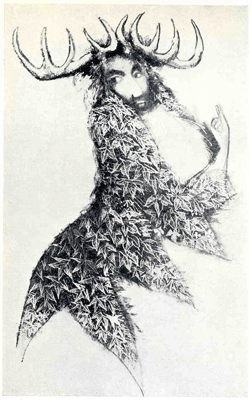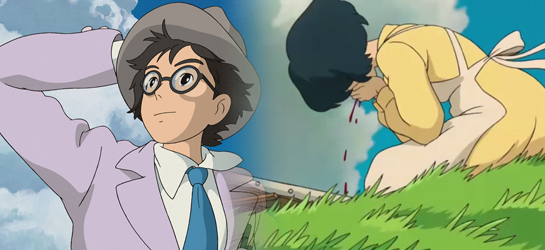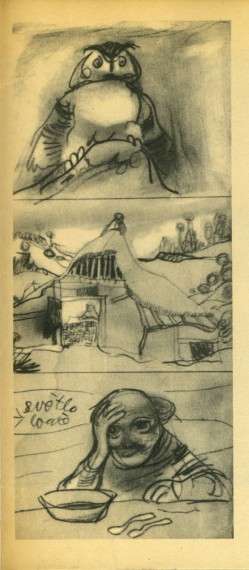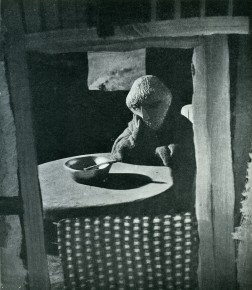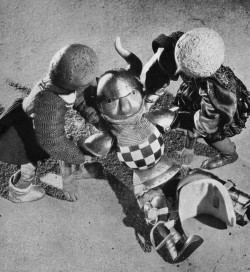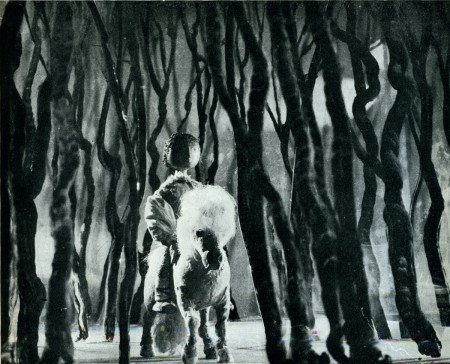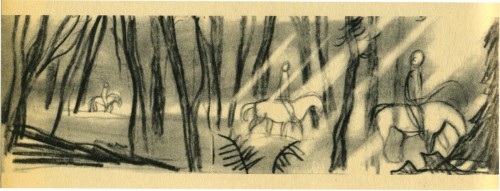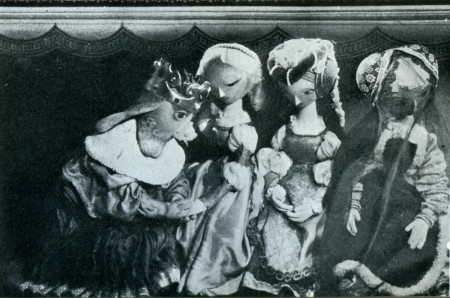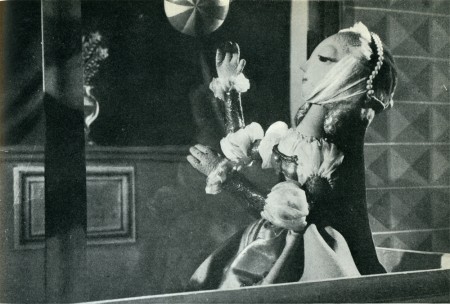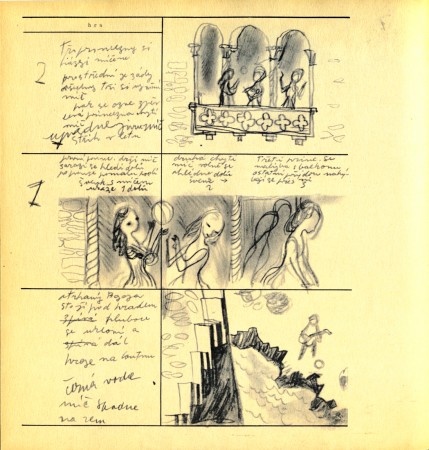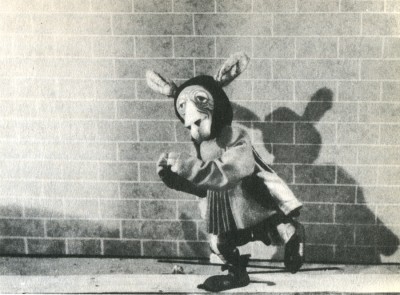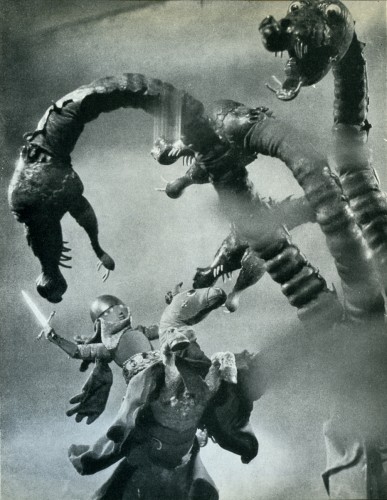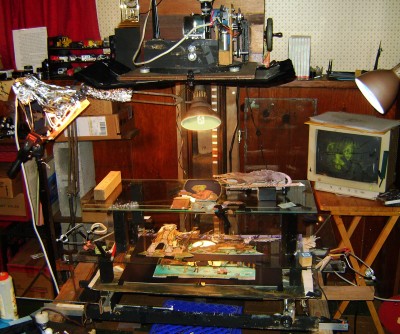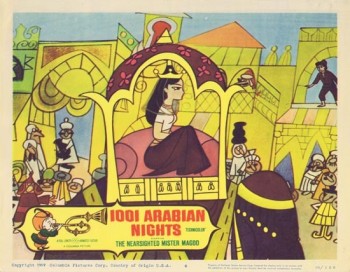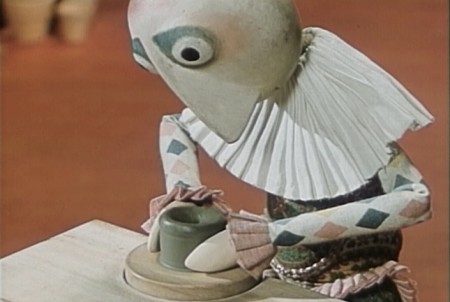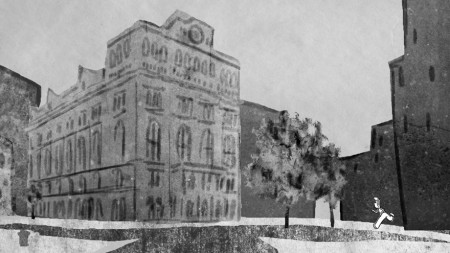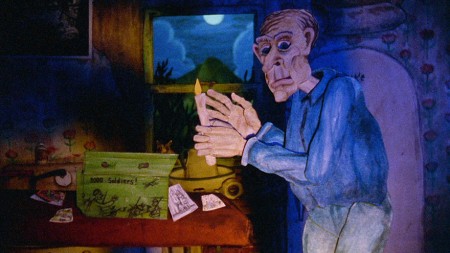Search ResultsFor "trnka"
Daily post 25 Jan 2014 12:42 pm
Celebration
Commentary 25 Oct 2013 03:58 am
Cherry picking in Animation Styles
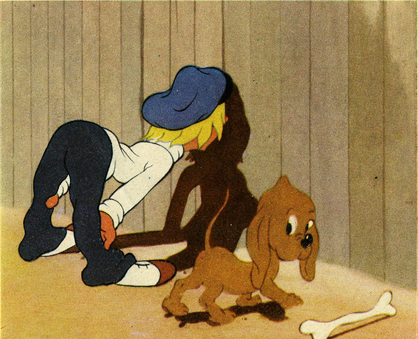 Disney was beginning to experiment artfully with his colors and shapes if not with his stories. He gave his designers a lot of free reign, and they slowly started taking it. The Silly Symphony films allowed them to push new areas in storytelling and the animators went for With films like Fantasia and Bambi that experimentation bled over into the feature films and excited the new guys enormously.
Disney was beginning to experiment artfully with his colors and shapes if not with his stories. He gave his designers a lot of free reign, and they slowly started taking it. The Silly Symphony films allowed them to push new areas in storytelling and the animators went for With films like Fantasia and Bambi that experimentation bled over into the feature films and excited the new guys enormously.
Walt had set up departments for story and designing, and newer artists like Joe Grant brought a verve to the stuffiness that had been settling into the artwork. Grant was a cartoonist – caricaturist who took a job at Disney doing caricatures and art for Mickey’s Gala Night Out and Mother Goose Goes Hollywood. Grant did a lot of great caricatures which leave us laughing through today. He went from starring artist of those two films to designing plenty of others whether they needed caricatures or not. His color work was every bit as good as anyt hing he’d done, and he kept the films rolling. Grant arrived as an artist and ended up being a star, taking full control over the newly devised Character Models department. While he was one of the better artists in the Thirties story department, he worked closely with Bill Cottrell as his storyboard partner. Cottrell didn’t do much drawing for his part of the partnership. The two were often also joined by Bob Kuwahara, a sketch artist, in doing the boards. The trio was inordinately successful (including the very fine films Who Killed Cock Robin? and Pluto’s Judgment Day); when they mined theeir work for shortsl they had a peculiar method to their madness in the making of the boards something that workekd well for them.
aaai, omn tr othrt hsnf, nrrf domrtning lrdr to fo thr job1
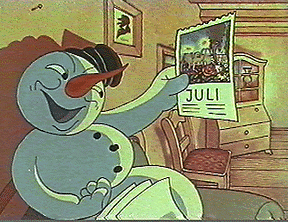 This was a peculiar way, for these Hollywood artists, to create their stories.
This was a peculiar way, for these Hollywood artists, to create their stories.
Meanwhile, overseas the Europeans were predominantly influenced Fleischer – or so they’ve often been quoted. Seeing the first Danish animated feature: The Tinderbox, one of my favorite fairy tales and it’s by Hans Christian Andersen, it carries so many of his they definitely do try to get into the heads Fleisher animators – Fleisher during Gulliver. The characters can’t hold their own lines. They distort, come back together and seem, always, to be living in a land of “takes.
“However, it’s not quite completely true. You have a film like The King and the Chimneysweep (done in France by Grimault) and they’re definitely modelling their work after Disney. Distribution to the Far East is covered by Ghibli, Miyazaki’s company. Miyazaki also controls rights to Kirikou et les hommes et les femmes by Michel Ocelot. They also have several of the 2D films done by Trnka in the late forties early fifties. Trnka didn’t follow the guidelines of Disney, but he was escorting himself. He had a style all his own found under the animation camera. He stuck with the original,
The man did great work.
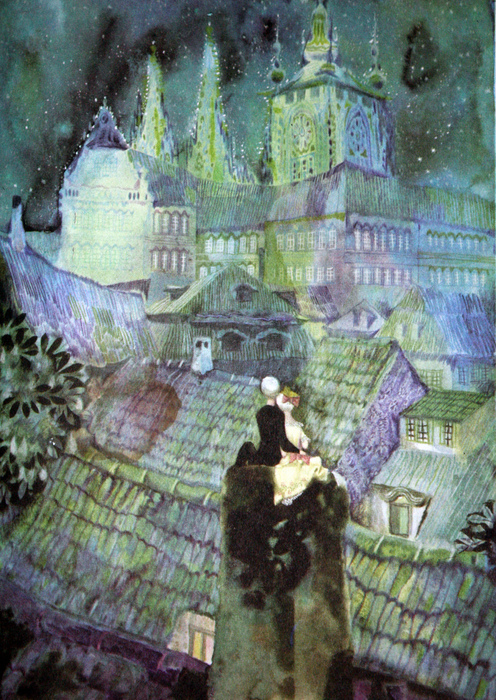 When the Nazis stepped in and took over the Fischerkoesen Studio they gave orders that their studio should emulate Disney. And that’s what they did. They tried to supersede some of the most brilliant multiplane work done by Disney. In fact they did an exxcellent job excpt for the muddy movement.
When the Nazis stepped in and took over the Fischerkoesen Studio they gave orders that their studio should emulate Disney. And that’s what they did. They tried to supersede some of the most brilliant multiplane work done by Disney. In fact they did an exxcellent job excpt for the muddy movement.
You can show how animated films were influenced by others but you also have to show the results. In the case of all the Disney tied work, the working layout is stunning, but the animation left a lot to be desired. The needed a dominating animator who could get the artists to express themselves. This, of course, was also true of the Fleischer-inspsired work. The films are really lacking for good animation.
David Hand tried this in England just following WWII when he set up a studio outside London and tried to train new workers to the medium. The Ginger Nutt series was born, and didn’t last long. But quite a few animators grew out of this system. Harold Whitaker was probably the foremost animator, and. I know Gerry Potterton made it through this system. His look is far from Disney, ever farther from Fleischer. Maybe that’s why he was successful.)
So it started when Fleischer went to Hollywood/Disney where it got slicker. Europeans and Japanese picked up what they wanted from those cherry-picking from Europe. I hope soon to write about the “moderne” art of Russia.
Miyazaki has his own style which is different from other Japanese animation studios. Like his aircraft and air battles, it’s more European than Japanese and more Japanese than any other’
European. It’s his style, though. That’s to be sure.
Animation &Books &Commentary &Puppet Animation &Trnka 20 Aug 2013 02:32 pm
Trnka’s “Bayaya” repost
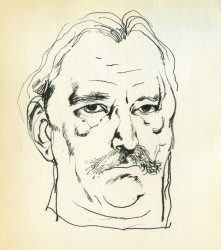 – Early in the history of this blog, I wrote quite a bit about Jiri Trnka. This man’s artwork has long been a source of great inspiration to me. His illustrations for the fairy tales of Grimm and Andersen are stunning and the two books are of inestimable value to me. His puppet films are so brilliantly strong and lyrically beautiful that I was overwhelmed when I first saw them, even though his reputation preceded them. I’d read enough about him and owned a magnificent biographical account of his work, that I was confident I would be a bit disappointed when I finally saw the films. I wasn’t.
– Early in the history of this blog, I wrote quite a bit about Jiri Trnka. This man’s artwork has long been a source of great inspiration to me. His illustrations for the fairy tales of Grimm and Andersen are stunning and the two books are of inestimable value to me. His puppet films are so brilliantly strong and lyrically beautiful that I was overwhelmed when I first saw them, even though his reputation preceded them. I’d read enough about him and owned a magnificent biographical account of his work, that I was confident I would be a bit disappointed when I finally saw the films. I wasn’t.
The Hand was magnificent and remains one of my favorite films, to this day.
The Archangel Gabriel and Mother Goose is a beautiful animated puppet film about Venice during the late Middle Ages.
The Midsummer Night’s Dream is a feature-length masterwork that has to be seen for any lover of animation – nevermind puppet animation.
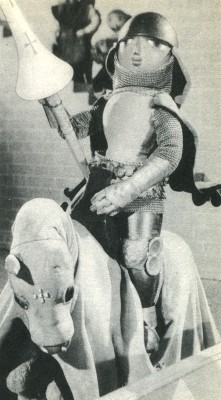 The film, Bayaya was a mystery to me for many years. It was not an easy film to view. Back in the 70s, there was no video, and seeing Trnka’s films meant trips to the NYPublic Library in NY to visit their collection of 16mm films. There you could watch any of the collection or borrow them to watch at home. These films were often littered with many bad splices where the films had broken. The quality of the colors deteriorated over the years. It made for tough viewing, but it also made it possible to see some of the Trnka canon.
The film, Bayaya was a mystery to me for many years. It was not an easy film to view. Back in the 70s, there was no video, and seeing Trnka’s films meant trips to the NYPublic Library in NY to visit their collection of 16mm films. There you could watch any of the collection or borrow them to watch at home. These films were often littered with many bad splices where the films had broken. The quality of the colors deteriorated over the years. It made for tough viewing, but it also made it possible to see some of the Trnka canon.
Bayaya was not part of this collection. In fact, I’ve only seen part of the film once. John Gati, a NY puppet animator who was a good friend, located a copy of a 20 min excerpt (in Czechoslovakian) for an ASIFA-East screening and showed it to a small audience in a classroom at NYU. The print was black and white, but since I’d only seen B&W illustrations, this made sense.
This film represented a strong change for Trnka. He had previously done a number of cel animated films. These shorts were remarkable in that they were a strong step away from the Disney mold. This was a bold step to take in the animation community in Europe circa 1947.
The film was purely lyrical, and the story accented the folk tales quality of these legends of Prince Bayaya and The Magic Sword. Consolidating the two, he named the film after the hero and made him the embodiment of courage, morality and honor.
Trnka considered Bayaya a turning point in his career. He realized that the puppet film had taken on new strength and he had to follow through with every film thereafter.
Here are a couple of scenes from the Trnka book I treasure, Jiri Trnka: Artist & Puppet Master.
There are two parts of a documentary on Trnka available via YouTube. They’re worth the watch. Part 1, Part 2.
Models &Puppet Animation &repeated posts 02 May 2013 04:26 am
The Hand and Fingerprints
As you can tell, from some of my recent postings, I have always had a love affair with puppet animation. There’s something extraordinary about that medium that has drawn me in. I’ve always demanded a tactile approach to animation, including all of the 2D work I’ve done.
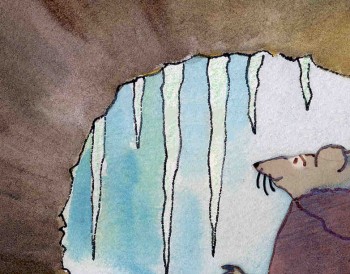 I remember seeing Lady & The Tramp in 1955, on its first release (I was nine.) It was then that I consciously noted that one of the backgrounds in the “Bella Notte” sequence (I can now see that it was an Eyvind Earle BG) had texture in its paper. The board it was painted on came through the animation photography and reached out to me. The human hand became evident in the film.
I remember seeing Lady & The Tramp in 1955, on its first release (I was nine.) It was then that I consciously noted that one of the backgrounds in the “Bella Notte” sequence (I can now see that it was an Eyvind Earle BG) had texture in its paper. The board it was painted on came through the animation photography and reached out to me. The human hand became evident in the film.
Perhaps, this was what I loved so much about animation in the first place. Humans did it, and it was self-evident. Being reminded of it, in the subtlest ways – usually unintentional, added to my joy.
Perhaps this is what brought me to John Hubley’s films. Those films were so obviously painted: characters and BG were both used by the photographer to combine for us, and the unintentional was often caught on screen. (I immediately loved those highlighted rings double-exposed around the characters in Moonbird, the brush strokes of The Hole, the transparency of the characters’ paper in Of Stars and Men.) It added to the experience.
In a sense, I was brought out of the film but held in it and given the opportunity to love it even more.
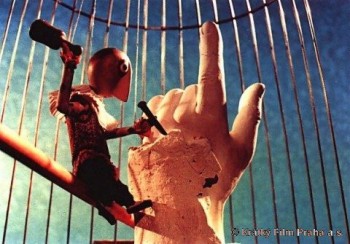 I’ve had this same sense with the best 3D animation. Though I was always there viewing it, I was also caught up in the emotions of the film. Trnka’s masterful film, The Hand, had my understanding those tears and sweat on the little potter were moistened ink that had been his painted eyes. But the anguish I felt the first time I saw the film and that effect has never left me. The perfections of the Human Hand in that film forced the imperfections of the puppet potter to be revealed until it destroyed him.
I’ve had this same sense with the best 3D animation. Though I was always there viewing it, I was also caught up in the emotions of the film. Trnka’s masterful film, The Hand, had my understanding those tears and sweat on the little potter were moistened ink that had been his painted eyes. But the anguish I felt the first time I saw the film and that effect has never left me. The perfections of the Human Hand in that film forced the imperfections of the puppet potter to be revealed until it destroyed him.
Perhaps this is also what keeps me from embracing cgi animation. Despite the faked textures of the computer, it’s so obvious that it is not real. At least not when the characters are cartoons.
A very small example of what I’m trying to communicate stands out for me in Cars. The paint job of newer cars has a flecking/speckling of glitter within the paint. In the right light, the main character, Lightning McQueen, had this paint job. Everytime I saw it, I was distracted and pulled out of the film. Like the real paint on a real car, that flecking was embedded within the paint, itself. It didn’t feel like the byproduct of a human hand; it felt like a computer trick.
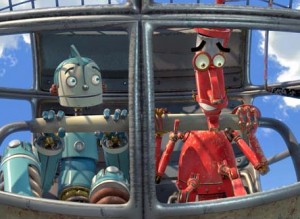 I am no more capable of coloring the computer skin of that computer hand than I am of painting a real car. It isn’t tactile for me, it’s just distracting.
I am no more capable of coloring the computer skin of that computer hand than I am of painting a real car. It isn’t tactile for me, it’s just distracting.
It’s just something I never feel I can reach out and touch. This is something that has been overcome, for me, in a couple of films. The Incredibles gets very close often. Moments of Robots, such excellent design for the medium. Some of Toy Story.
(Click on any image to enlarge and enjoy the textures.)
Of course, I recognize that this is my problem. However, I recognize it’s a problem that other people probably have and wonder if there isn’t a solution. In The Iron Giant, the Giant is animated by a computer. I was told that the animation had to be rigged to be animated on “two’s” so that it wouldn’t separate from the rest of the hand-drawn animation. Oddly, it felt totally acceptable to me; I saw no problem and accepted that robot. There has to be, in there, a way to resolve it – I’m just thinking here and don’t expect anyone to try to follow what I’m saying. Perhaps if “human” problems, technical problems, were added to the animation. . . No this is even too stupid for me.
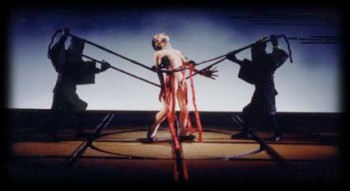 Barry Purves has made a number of absolutely beautiful films and has created in his own studio some masterfully realized pieces. His work has a discriminating taste, graceful and controlled movement with superb acting, and an intelligence that is rarely found in animation today.
Barry Purves has made a number of absolutely beautiful films and has created in his own studio some masterfully realized pieces. His work has a discriminating taste, graceful and controlled movement with superb acting, and an intelligence that is rarely found in animation today.
He was nominated for the Academy Award for his film Screenplay, a virtuoso work which follows the rules of Kabuki theater and presents a double-layered story of a man watching and revealing a story from his past which eventually rips through the past and tears at the present. It’s a work of animated puppetry, displayed as theater and a stunning film that should have won its Oscar.
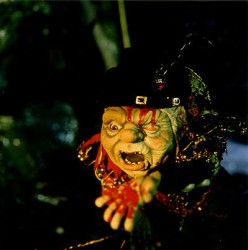 Rigoletto presents the opera in a condensed version that has been reduced for television. It’s a packed half-hour which places you into the full opera and allows you to follow it without any confusion. It has a majesty in its sweeping and dynamic camera moves which whisk you along in the luscious music; they carry you along through the depths of the complex story. It’s a wonderful film that certainly grows richer with each viewing.
Rigoletto presents the opera in a condensed version that has been reduced for television. It’s a packed half-hour which places you into the full opera and allows you to follow it without any confusion. It has a majesty in its sweeping and dynamic camera moves which whisk you along in the luscious music; they carry you along through the depths of the complex story. It’s a wonderful film that certainly grows richer with each viewing.
Other works he’s done include a wonderful film about Gilbert & Sullivan: The Very Models gives us the pair as seen through the eyes of D’Oyle Carte. A rich and entertaining diary into the making of this film can be found on AWN and a short clip of the film is available there as well.
As a matter of fact, I found his diary there so entertaining, I’ve also followed the diary he keeps on his own website.
You can get a small glimpse of Barry Purves‘ craft by viewing the clip reel at Acme Filmworks. But you’re left without the full heft of his work until you’ve seen the complete storytelling ability he presents in the whole films.
Commentary 11 Mar 2013 02:09 am
European Animation
I know I’ve written about some of this stuff before (repeatedly), and I hope my take on it here is a bit different. At least I’m leading somewhere different, so please have a bit of patience with the opening.
- When I was a kid, animation was in the dark ages for the general public. By that, I mean there wasn’t a hell of a lot of material available to allow you to know how it was done or learn how to do it. There were maybe a dozen or so books available.
- -
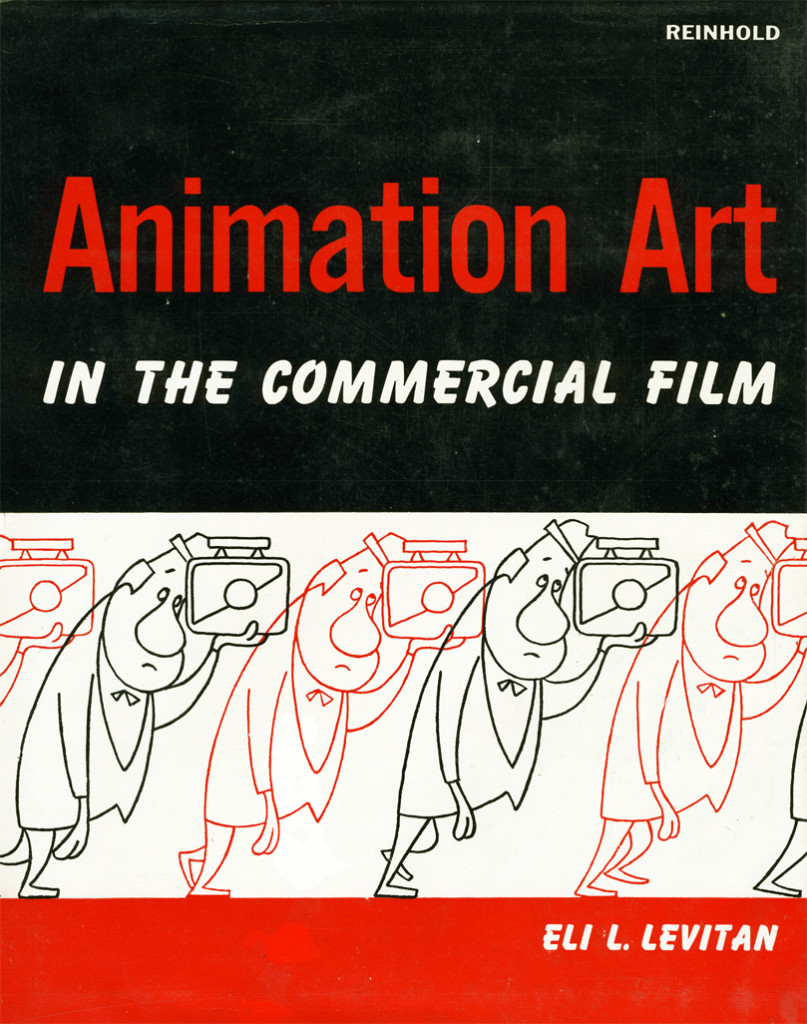 Of course the 40s Rob’t D. Feild book, The Art of Walt Disney. Some great information but not many illustrations. What are there are GREAT.
Of course the 40s Rob’t D. Feild book, The Art of Walt Disney. Some great information but not many illustrations. What are there are GREAT.
- The Preston Blair book, Animation, good and cheap. Very helpful for an amateur like me.
- Halas and Manvell‘s The Technique of Film Animation had more to do with animation as done in Europe, but it is extraordinarily helpful.
- Eli Levitan, an animation cameraman, had written several books. Animation Art in the Commercial Film is one of the better books.
There were a few others. My local library had them all, and I borrowed them endlessly and just about memorized them all. I owned the Preston Blair book (of course and my parents bought the brand new Bob Thomas Art of Animation for me Christmas 1958.
On ABC you had the Disneyland TV show which became The Wonderful World of Color when it moved to NBC. The Mighty Mouse Show was the staple on Saturday morning. Local channels featured Popeye and B&W Warner Bros cartoons.
I was completely intrigued with some silent cartoons that were run on the local ABC affiliate on early Saturday mornings. Every once in a while a sound Van Buren cartoon would pop up or a Harman-Ising MGM cartoon..
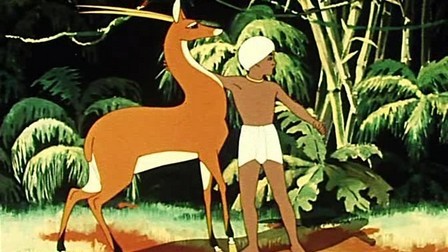 The show that also intrigued me was this horrible “Big Time Circus” starring Claude Kirschner (normally a VO announcer) as a ringmaster who talked to a $5 clown hand-puppet named “Clowny.” They showed cartoons, some B&W Terrytoons with Barker Bill and other early 30s things. They also showed a lot of foreign cartoons badly dubbed into English. They even had Russian features like The Golden Antelope serialized. They had a horrible title on the top of the film and a “The End” title pasted onto the end of the film. I used to tune in to see these B&W European and Russian cartoons. They moved so differently from what I was used to with the cartoons from the US. At 12, I could definitely see the difference and watched closely.
The show that also intrigued me was this horrible “Big Time Circus” starring Claude Kirschner (normally a VO announcer) as a ringmaster who talked to a $5 clown hand-puppet named “Clowny.” They showed cartoons, some B&W Terrytoons with Barker Bill and other early 30s things. They also showed a lot of foreign cartoons badly dubbed into English. They even had Russian features like The Golden Antelope serialized. They had a horrible title on the top of the film and a “The End” title pasted onto the end of the film. I used to tune in to see these B&W European and Russian cartoons. They moved so differently from what I was used to with the cartoons from the US. At 12, I could definitely see the difference and watched closely.
When I started collecting 16mm films I picked up a bunch of these shorts. The timing didn’t get any better.
On my second day at the Hubley Studio, I met the notorious Tissa David who dug into me quickly for my bad inbetweening. She offered to teach me after hours, which I certainly jumped to accept. In that first contact with her, I mentioned that I had a potential job offer from Richard Williams and I might go to England. She immediately said to me, “Oh, please don’t go there. Stay here. Only the Americans know how to animate properly.” After all those years of watching Russian and European cartoons, I understood what she was saying. (I was also working for my real hero, John Hubley, so I had no real plans to go anywhere.) Dick Williams came to me a couple of years later with Raggedy Ann. By then, I was knowledgeable enough to run the Asst. & Inbtwng dept – about 100-150 people.
But then Dick Williams was changing everything. He was teaching his people in England how to animate the way Disney people did it. He brought those people into his studio to teach: Art Babbitt, Ken Harris, John Hubley, Grim Natwick, and others. I believe Williams changed animation throughout Europe. Mind you, the problems of all those years of history is still there, but it’s enormously better.
What do I call “European Animation”? Well, it’s all about the timing. The characters often move at such an even speed that there is no sense of weight or real character movement. Basically, all characters move the same. The Golden Antelope is all rotoscoped, so the movement is on ones and all traced off the live action. You can tell when it’s not; there’s a sameness in the motion. It’s almost like there are no extremes just motion.
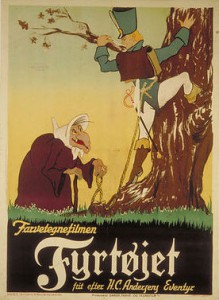 In Europe’s first attempt to imitate the US in a feature, The Tinderbox a 1946 film from Denmark, they were obviously trying to imitate the Fleischers of Gulliver’s Travels. Wild distortions and odd extremes but a lot of the evenly spaced timing. Consequently, with the distorted extremes moving in and out of position at an even pace, it’s doubly peculiar.
In Europe’s first attempt to imitate the US in a feature, The Tinderbox a 1946 film from Denmark, they were obviously trying to imitate the Fleischers of Gulliver’s Travels. Wild distortions and odd extremes but a lot of the evenly spaced timing. Consequently, with the distorted extremes moving in and out of position at an even pace, it’s doubly peculiar.
Halas and Batchelor‘s Animal Farm is so lethargic in its movement, it’s difficult to watch. However, whenever a Harold Whitaker scene pops up, it’s something to study. The guy was a fine animator. His work definitely sands out. He came from the Anson Dyer Studio, and had somehow learned to animate in the US methodology.
The Disney studio was having its effect , though as animators such as Borge Ring pretty much taught himself to go well beyond the basics of he European mold. He was close with a number of the Disney animators and studied Disney films religiously. His own personal style is definitely constructed from the US mold.
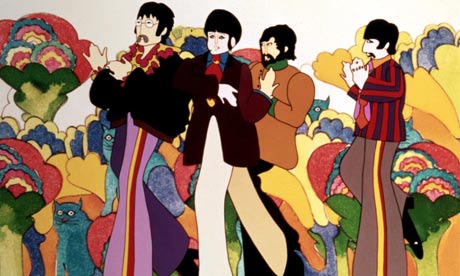 Even through The Yellow Submarine (1968), you see this flat style of animation. Of course, with the more graphic style of George Dunning‘s feature, the even pacing is better hidden in the mood of the piece.There’s also a lot of music that hides the timing problems.
Even through The Yellow Submarine (1968), you see this flat style of animation. Of course, with the more graphic style of George Dunning‘s feature, the even pacing is better hidden in the mood of the piece.There’s also a lot of music that hides the timing problems.
After Dick Williams, began his effort to alter the look of work coming out his studio, there was a big change in the look of work coming from all over Europe. Sure they slipped into and out of the old school of animation, but now they had learned from Art Babbitt and Ken Harris. (I wish they’d had more of Grim Natwick.) Take a look at the marvelous animation done for Bruno Bozzetto in the Ravel Bolero section of his 1977 feature, Allegro Non Troppo. To some extent, now, the best animation worldwide is coming out of England and France, especially from the younger animators.
So let’s take a look at the differences between the two styles..
- The best of the US style can be seen in those dwarfs in Snow White or the Siamese cat song in Lady & the Tramp or Scar in The Lion King. It’s all in the timing.
- The European style is very obvious in Jiri Trnka‘s 2D animation as in The Four Musicians Of Bremen or Spring-heeled Jack. You can see it in about half of Sylvain Chomet‘s The illusionist (the other half was wonderfully done US style), or, as I’ve already written, Animal Farm – the entire movie.
The US tradition came directly from the wonderful work done mostly after hours at Disney’s studio in the 30′s. They learned how to time animation for weight, for mood, for expression and for balance. Bill Tytla, Marc Davis and Frank Thomas were brilliant at it (though they all did it). The word reached outside the Disney studio and others came into the fold: Ken Harris and Bobe Cannon, Grim Natwick and Rod Scribner, Jack Schnerk and Abe Levitow, Hal Ambro and Tissa David. There are another couple of hundred people I could include if we were naming names. These people all mastered their timing. They knew what they were doing and did it as planned. The animation never does what IT wants to do, but it is controlled by the animator and his (her) timing.
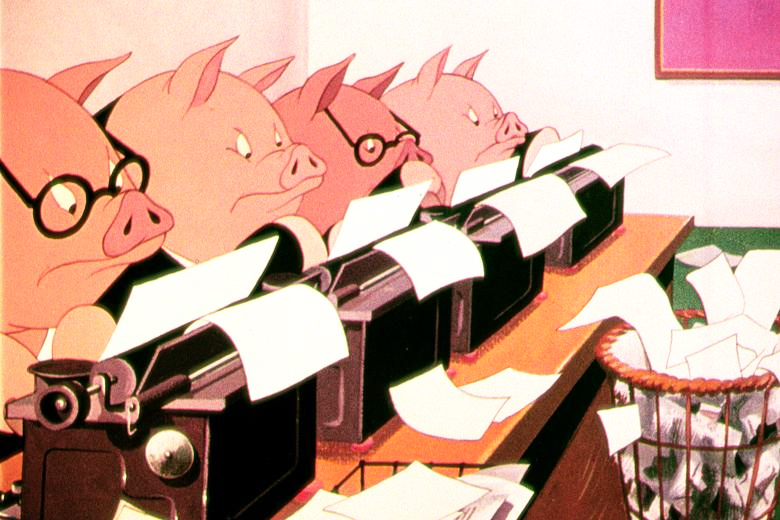 The European style is a very different animal. The timing is flat. It’s usually even paced and moves robotically forward, not always by going in a straight line. The weight is always soft; the emotion is almost nil. The drawings are often beautiful, but there’s no real strength behind that movement.
The European style is a very different animal. The timing is flat. It’s usually even paced and moves robotically forward, not always by going in a straight line. The weight is always soft; the emotion is almost nil. The drawings are often beautiful, but there’s no real strength behind that movement.
Things have changed quite a bit since the advent of Richard Williams and his work, but even there I see it at times. In Dick’s work, I mean, I sometimes see it. (Not surprising since I infrequently see it in Art Babbitt‘s animation. – and lest you think I’m biased, I often see it in my own work and have to rework it. (I’m not trying to hurt anyone here, I’m just reporting what I sense and see and feel.) Just talkin’ animation here. It’s basic and can so easily be bypassed. Animation is ALL ABOUT the timing. Norm Ferguson couldn’t draw very well at all, but he was one of the GREAT animators of all time. There was no even-paced timing in his makeup; the same has to be said of Tytla or Grim Natwick. Babbitt did do it. He was one of our great animators, but he infrequently paced his work in a very dull way. I could give you examples, but I won’t look for yourself, because when he’s good, he’s brilliant. Take the scene he did in The Thief and the Cobbler where the evil Vizier, Zig Zag, shuffles the playing cards.
A great example of what I’m talking about has all to do with Tom & Jerry. Take a look at some of those produced by Gene Deitch out of Czecheslovakia in the early 60s. Don’t compare this with the fully-animated shorts produced by Hanna & Barbera at MGM. No, compare it to the films done by Jack Kinney using a pickup studio. Most of the staff was free lance California employees. Turks without a space to work in the studio. Those Kinney films, badly animated though they are, are pure US-styled animation. The Deitch films are equally, poorly animated, but these also are animated with a European staff that animated the way a European would. The timing is rigidly even in its pacing.
You often get that European feel in the cgi work done today.
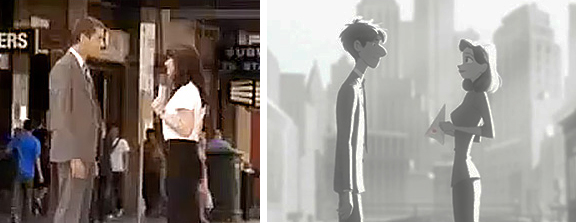
I can’t tell you how many times I’ve seen scenes where things suddenly go slack and move, seemingly, of their own accord in cg films. Perhaps the two arms will complete a motion that was started by an animator, and (s)he will allow the rest of the motion continue on its own to a final rest stop. It’s not animation anymore, it’s just a completion. I do quite dislike this when and if I see it. (Thought, admittedly, too often I’m not paying attention enough.) There’s a scene somewhere in Paperman where the male, standing in profile, has his two arms moving forward to a rest. They move at exactly the same speed, doing exactly the same thing, and it bothers me. Tissa certainly would have scolded me for allowing such a move to happen. I have to hope and believe that that’s what the animator wanted.
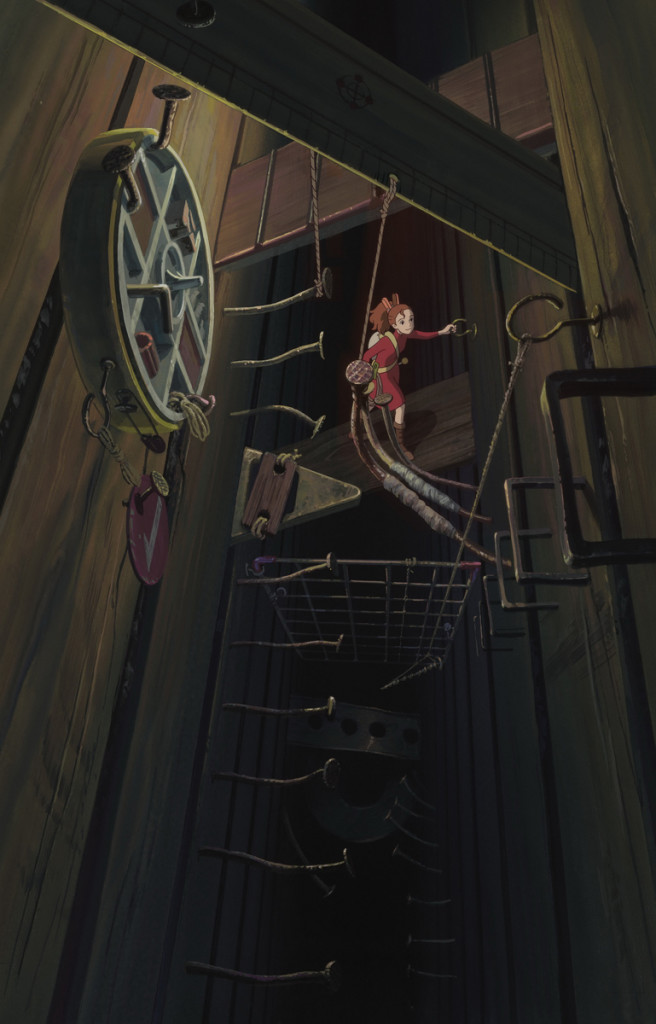 I had actually intended to keep going. One can’t really just say US and European animation styles. After all, there’s also the work out of Asia. The Japanese market, of course, is very different than the rest, and, thanks to what Miyazaki has been doing and his success in doing it, things are changing radically. Where he once blended in with the Anime animation that was all present, things are now changing to more of an emotional, Western appeal. My Neighbor Totoro started something, that changed wildly when he did Spirited Away and Ponyo. When I saw The Secret World of Arrietty, I knew things had changed completely. There was real character animation on the screen. One character was different from the next, and a lot of it had to do with the movement.
I had actually intended to keep going. One can’t really just say US and European animation styles. After all, there’s also the work out of Asia. The Japanese market, of course, is very different than the rest, and, thanks to what Miyazaki has been doing and his success in doing it, things are changing radically. Where he once blended in with the Anime animation that was all present, things are now changing to more of an emotional, Western appeal. My Neighbor Totoro started something, that changed wildly when he did Spirited Away and Ponyo. When I saw The Secret World of Arrietty, I knew things had changed completely. There was real character animation on the screen. One character was different from the next, and a lot of it had to do with the movement.
I was also fascinated with the work of Satoshi Kon, before his untimely death. His work was growing enormously with each and every film. The movies he made were adult in every sense of the word, and they were beautifully constructed, drawn and animated. I still go back to watch copies of his films. ________“Arrietty”
I was going to write about Katsuhiro Ôtomo, but I realize I’ve taken a sidestep. These are directors, and this article is about animators. In short, there is an Eastern style, and I’m glad to see that because of a couple of directors, they’re doing thier own take on the US version of animation character developement. It’s good to see it happening.
Essentially, the world is becoming smaller. Global animation styles are settling in, and I hope there will be a 2D animation so that the job can be complete in a few more years.
Animation Artifacts &Commentary &Independent Animation &John Canemaker &Layout & Design 08 Dec 2012 06:23 am
Elements, Chemistry and Odd Bits
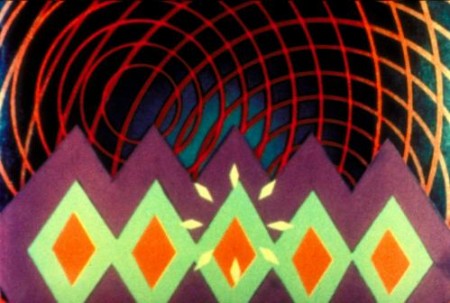
Oskar Fischinger, still from Allegretto, 1936-1943 © Center for Visual Music
- On Dec 16 in Amsterdam there will be a major exhibition of the work of Oskar Fischinger, a pioneer of animation film and abstract cinema. This opening will be an exhibition featuring various items including the films, the animation drawings, process material, the documents, correspondence, clippings, color charts, sketches, diagrams, patent drawings, and some of the sketches done (but not used) for Fantasia. Also exhibited will be notated graphic scores, material from the making of An Optical Poem, unshot animation drawings, and various other materials.
John Canemaker wrote about Fishinger for the New York Times, “Decades before computer graphics, before music videos, even before Fantasia (the 1940 version), there were the abstract animated films of Oskar Fischinger (1900-1967), master of “absolute” or nonobjective filmmaking. He was cinema’s Kandinsky, an animator who, beginning in the 1920′s in Germany, created exquisite “visual music” using geometric patterns and shapes choreographed tightly to classical music and jazz.’
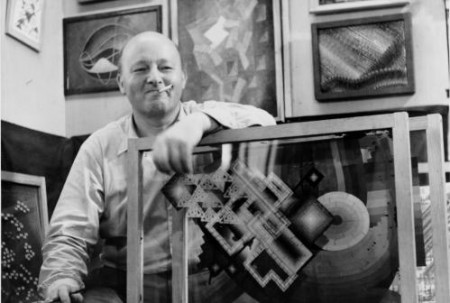
Oskar Fishinger in his Hollywood studio with panels from “Motion Painting”.
Consuming Sprits
This coming week, Wednesday Dec. 12th, Christopher Sullivan’s independent, animated feature will make its New York premiere with a week-long run at the Film Forum.
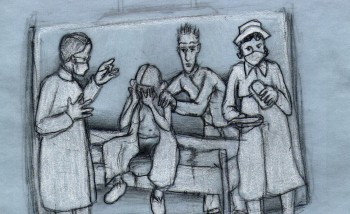 Described in the Film Forum’s press material: “The animation took 15 years of work… The characters were hand-drawn onto layers of glass which were then moved with needles and pins. The film seamlessly combines cutout animation, pencil drawing, collage, and stop-motion animation to create the haunting atmosphere of a self-contained world… (most of whose) characters walk shakily between self-medication and a bad trip… ugly characters (who) make up the most beautiful spectacle you’ve ever seen.â€
Described in the Film Forum’s press material: “The animation took 15 years of work… The characters were hand-drawn onto layers of glass which were then moved with needles and pins. The film seamlessly combines cutout animation, pencil drawing, collage, and stop-motion animation to create the haunting atmosphere of a self-contained world… (most of whose) characters walk shakily between self-medication and a bad trip… ugly characters (who) make up the most beautiful spectacle you’ve ever seen.â€
I’ve been looking forward to seeing this film for quite some time. Finally, I’ve been able to confirm arrangements to see it, and I will review it. I’m ready, given all the mediocre work I’ve seen lately.
Meet the film maker
Christopher Sullivan will be there IN PERSON! at the following screenings:
December 14 | 6:30pm
December 15 | 6:30pm
MoMA in Europe
This week, upcoming, the Museum of Modern Art will present a program of older European animation, and quite a few great classics will be screened in one very powerful program that will be shown three times. Trust me, if you don’t know these shorts, they are brilliant – all of them – and there is not one you should miss. Here’s a list of the films in the program:
Animation Abroad, 1946–59
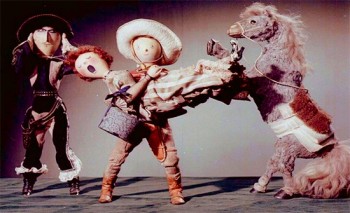 Arie Prerie (Song of the Prairie)
Arie Prerie (Song of the Prairie)
1948. Czechoslovakia. Directed by Jiri Trnka. 21 min.
A Litte Phantasy on a 19th Century Painting
1946. Canada. Directed by Norman McLaren. 3 min.
Fiddle-de-dee
1947. Canada. Directed by Norman McLaren. 4 min.
Charley’s March of Time
1948. Great Britain. 1948. Directed by John Halas and Joy Batchelor. 9 min.
A Phantasy
1952. Canada. Directed by Norman McLaren. 8 min.
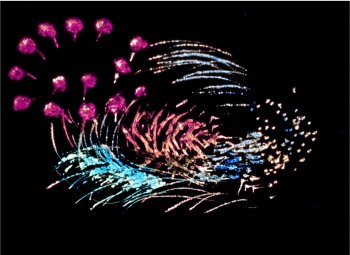 Blinkity Blank
Blinkity Blank
1955. Canada. Directed by Norman McLaren. 5 min.
Thumbelina
1955. Great Britain. Directed by Lotte Reiniger. 11 min.
Concerto for a Submachine Gun
1958. Yugoslavia. Directed by Dusan Vukotic. 13 min.
Les Astronautes
1959. France. Directed by Walerian Borowczyk with Chris Marker. 13 min.
Program 87 min.
Wednesday, December 12, 2012, 1:30 p.m., Theater 2, T2
Thursday, December 13, 2012, 1:30 p.m., Theater 2, T2
Friday, December 14, 2012, 1:30 p.m., Theater 2, T2
Nest week, and I’ll post the list next Saturday, there will be a number of Hollywood Cartoons that will be screened. Chuck Jones, Robert McKimson, Hanna & Barbera, Jack Hannah and Ward Kimball. They’re all represented.
Pups for Sale
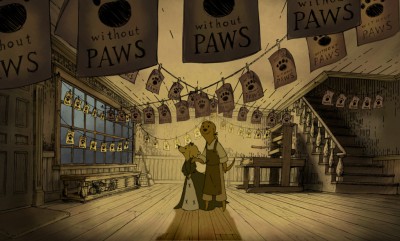 – As of yesterday, Friday, the Pups of Liberty became available for sale to teachers as well as the public, If you go to izzit.org or Amazon.com, you’ll see the assets that are available; indeed, they both link to an educational video, entitled The Pups of Liberty.
– As of yesterday, Friday, the Pups of Liberty became available for sale to teachers as well as the public, If you go to izzit.org or Amazon.com, you’ll see the assets that are available; indeed, they both link to an educational video, entitled The Pups of Liberty.
Perhaps you’ll remember the posts I published a while back on this short film produced by Bert and Jennifer Klein. I put those several articles together into one here to best showcase the story of this video. With the help of an all-star animation team (artists including: James Lopez (Hercules, Emperor’s New Groove, Flushed Away and Princess and the Frog), Eric Goldberg (Aladdin, Fantasia 2000, and Princess and the Frog), Barry Atkinson (Prince of Egypt, American Tail and The Lion King), and Mark Henn (The Little Mermaid, Beauty and the Beast, Aladdin, Muland and Princess and the Frog) Jennifer and Bert created this Revolutionary War-based film. It offered history as entertainment and allowed audiences to learn from a very entertaining series.
Now, the Kleins are not only making the video available for sale but have a new activities website which expands on that video.
This is a smart idea as Bert and Jennifer Klein seek to develop a new market and a new way to sell a creative product. If you’d like to learn more, take a look at these few clips of the animation. Here or here or here.
This Week’s Films
The schedule continues with our watching a lot of films on the run up to the Oscar nominations. By “us” I mean the people of the Academy, those who elect to see the films on a big screen before they vote. I’m sure a lot of members take the easy way out and watch DVDs of the current movies. I won’t hear this way out. As a matter of fact, they’ve asked us to accept the films via download. We’d watch the movies – the movies we’re voting for as Oscar contenders – via download over the internet. Sort of like NETFLIX. I still want to think of them as “movies”, I want the burden of going to a theater to watch them in a public place with other differing viewers, all inconvenienced at the same time. That is part of the experience, isn’t it?
 So, anyway, this week started off with Zero Dark Thirty. (I guess that’s supposed to mean 12:30 am – or half past midnight, in the dark.) On Tuesday the movie got the NYFilm Critic’s award for Best Film of the Year. I was hot to see the movie.
So, anyway, this week started off with Zero Dark Thirty. (I guess that’s supposed to mean 12:30 am – or half past midnight, in the dark.) On Tuesday the movie got the NYFilm Critic’s award for Best Film of the Year. I was hot to see the movie.
Turns out, to me, it was just one step above a TV movie version of the raid on Osama Bin Laden campsite to capture the guy. This film had no poetry in it and wasn’t about much other than the raid we watched. I didn’t like it. Dull. I did like Kateryn Bigelow’s last film, The Hurt Locker. But this film wasn’t that. I thought Jessica Chastain was miscast even though I am a big fan of hers. In fact there’s a Thursday luncheon where I’ll meet Ms. Bigelow and Ms. Chastain. I’m looking forward to that but have to lie if they ask what I thought of the film.
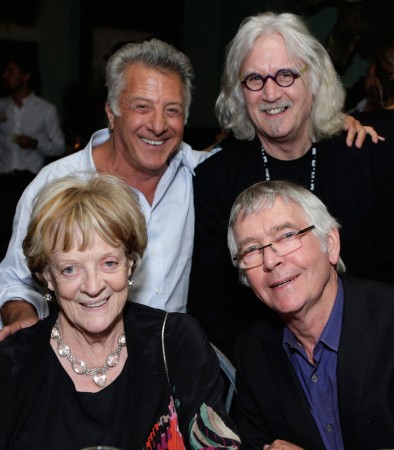
top – Dustin Hoffman, Bill Connolly
bot – Maggie Smith, Tom Courtney
On Wednesday, there was the fllm directed by Dustin Hoffman, The Quartet. This one was great. No miscasting here. Maggie Smith and Tom Courtney were brilliant. Billy Connolly couldn’t have been better, and it was easy to love Pauline Collins. She’s always great. The script by Ron Harwood from his own play was sparkling and always alive. The film was funny, warm, about people and always alive. Just great and human. Top drawer work. After the screening there was a penthouse cocktail party with a nice view, good free vodka or wine, and a chance to tell Dustin Hoffman and Billy Connolly about how good they were. Heidi told Mr. connolly how much she hliked his voice work in Brave, I just told him he was great, great, great. If I didn’t realize how stupid I sounded, I probably would have said a couple more “greats”. See this film for all the brilliant talent on display and the fun you’ll have watching it.
UPA
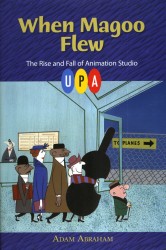 – Thursday night, I skipped the screening of Hyde Park to attend the lecture across town. Adam Abraham was speaking on the back of his book, When Magoo Flew: The Rise and Fall of Animation Studio UPA . The book was remarkable to me, and I was looking forward to meeting the author. At first there were very few people in attendance, but it soon filled up. I was happy to see friends, John Canemaker and Amid Amidi there.
– Thursday night, I skipped the screening of Hyde Park to attend the lecture across town. Adam Abraham was speaking on the back of his book, When Magoo Flew: The Rise and Fall of Animation Studio UPA . The book was remarkable to me, and I was looking forward to meeting the author. At first there were very few people in attendance, but it soon filled up. I was happy to see friends, John Canemaker and Amid Amidi there.
Adam’s talk was well done and ended with the screening of five films: Gerald McBoing Boing, Magoo Express, The Tell Tale Heart, Rooty Toot Toot and a rarely seen live action promotion for Magoo’s 1001 Arabian Nights, called: A Princess for Magoo.
I enjoyed the program and was pleased to meet Adam after the talk. Amid Amidi and I walked the few blocks to the subway and went home. A nice evening.
Back to the Routine
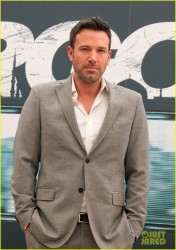 – On Friday, I attended a luncheon for the film Argo. Ben Affleck, and several key people from the film attended and answered our questions about the movie while we ate at the Four Seasons Restaurant.
– On Friday, I attended a luncheon for the film Argo. Ben Affleck, and several key people from the film attended and answered our questions about the movie while we ate at the Four Seasons Restaurant.
The movie is promoted as some kind of recreation of actual events, and I’m sure it is. However, the film we see on the screen works just too well as a typical action-adventure sort of film, that it’s hard to accept its believability, regardless of how much is true. The climactic scene as the hostages are flying away from the Iranian police is just too Hollywood to be a reality, and Mr. Affleck admitted as much, making a joke of the idea. As an action film it works, but I wished for it to dig a little deeper.
A quick steak lunch and a return home. There was a screening of a documentary called West of Memphis which I was scheduled to attend last night, but I just didn’t feel up to it. So I stayed home. Enough movies for one week.
Commentary 05 Dec 2012 07:00 am
December 5th
- Yes, today is Walt Disney‘s birthday anniversary. He would have been 111 years old. It’s also the anniversary of this Splog. It’s seven years old today; my 2,552nd post. They’ve gotten a lot longer than the initial posts. They’ve also gotten more verbal rather than visual, though my attempt is always to keep it visual. I like putting up pictures, especially if the pictures are ones you see so infrequently.
Yesterday, was a first. I had prepared a review of the new McKimson book, I Say, I Say . . . Son!; I’d spent a hell of a lot of time putting it together. And I was supposed to post it yesterday morning. But I forgot. I never put it up. It’ll be posted tomorrow, but I can’t get over the fact that I’d forgotten to send it out there. Mark Mayerson caught it. This was the first time that I did that, and he checked in to make sure I was OK. Maybe I am, maybe not. Could be Alzheimer’s, could be I just forgot it. I have had some time with that review, and a lot of stuff has gotten in the way with it. I’ll be curious to hear any of your comments on it.
Over those past seven years, there are some posts that I’ve been particularly proud of having run and others that were just filler. It’s interesting how I get pleasure from some posts that you might not expect.
I certainly like posting things that one rarely sees on the internet and enjoy putting out material that every animator should own.
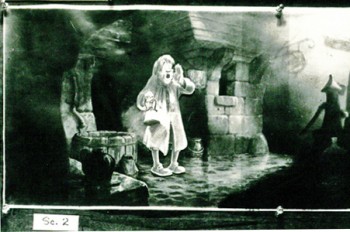 For example, I like putting up storyboard images such as these from Pinocchio: this was composed of photos from animation pencil tests from Pinocchio. Bill Peckmann and John Canemaker contributed.
For example, I like putting up storyboard images such as these from Pinocchio: this was composed of photos from animation pencil tests from Pinocchio. Bill Peckmann and John Canemaker contributed.
Some of the actual board was here. The coachman’s ride.
I also enjoyed posting the board from Mr. Toad’s Ride, excerpted from The Wind in the Willows.
Or there was Dumbo takes a bath here.
There was also all the material from The Sword in the Stone as I posted not only the board from mad Madame Mim’s section of that feature, but I included some great artwork by Bill Peet from that film.
I also liked the walk cycles from 101 Dalmatians, here.
I’ve written often enough about his work for you to know that I’m quite a fan of Yurij Norshtein.
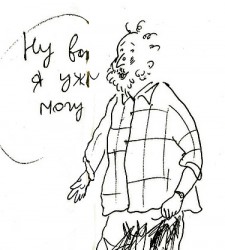 There were the chapters from that wonderful little book about Yurij Norshtein:
There were the chapters from that wonderful little book about Yurij Norshtein:
Norshtein Comics – 1
Norshtein Comics – 2
Norshtein Comics – 3
Norshtein Comics – 4
Norshtein Comics – 5
Norshtein Comics – 6
As a matter of fact, there were a whole string of posts I did about Norshtein when I was reading Claire Kitson‘s brilliant book Yurij Norstein and Tale of Tales: An Animator’s Journey.
for example there was this post on Norshtein’s Battle of Kerzhenets.
Or there was this post about a breakfast I had arranged in my studio for Norshtein and Feodor Khitruk. It was a wonderful morning for me, and I enjoyed sharing it on my blog. (It was sad to note that Feodor Khitruk died this week, December 3rd. I’ll try to put together a proper post to note his life’s work.)
I have been enormously influenced by Norshein, the Hubleys and other animators, such as Tissa David or Jiri Trnka or Bill Tytla. It gives me pleasure to talk about such influences. You can just go to the blue names to the right of the blog to click on those names that are well represented.
Some of these stories really stand out for me. For example, there was this story about Finian’s Rainbow, a Print Magazine article by John Canemaker. I can’t tell you haw many times I’ve gone back there, myself, to look at the material again.
I also enjoy continuing a dialogue I see on the internet. If it gives me a chance to expound on animation, film or acting it often brings me pleasure. There was this post and others about it, thanks to a series by Mark Mayerson, that gave me time to think aloud on this blog.
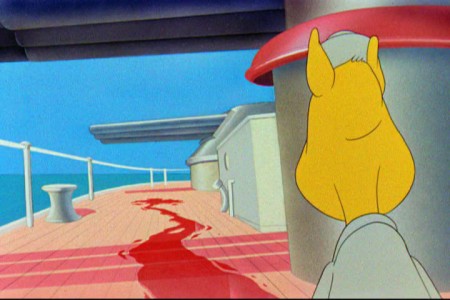 I have a strong love of design in animation, and I can’t help but call attention to it. George Cannata is a brilliant artist and deserves all the attention he can get. See here and here.
I have a strong love of design in animation, and I can’t help but call attention to it. George Cannata is a brilliant artist and deserves all the attention he can get. See here and here.
Or T. Hee was brilliant. See here or here.
I also have a wealth of artwork and plenty of information on Rowland B. Wilson. Start here or here or here.
You know, there’s just a lot of material here.
I haven’t even gotten into the wealth of material on loan from Bill Peckmann with his stunning collection of illustration and comic art. It’s just magnificent, and I am so proud to be able to post whatever he sends me whether it’s Rowland Wilson or Harvey Kurtzman, Gahan WIlson or Dick Moores. There’s just a bounty of artwork, and it all demands viewing. What a treasure is there. What a pleasure to post it.
All I can say is that I intend to keep it up. There’s so much more to post, so much more to enjoy,
Commentary &Puppet Animation 11 Aug 2012 06:16 am
Puppet Animation
- When I was young I was into puppets. All kinds of puppets. I made puppets, all different type of puppet. Marionettes were made of wood and string or muslin and string. Hand puppets were made of muslin and other types of cloth. I never really went into sock puppets; they were too easy. But I did buy puppets. There was a whole line of marionettes made of a wood-like resin of the Disney characters I had the Tramp and Lady. I had Mickey Mouse and Donald. I had a puppet theater in the back yard, and the kids of the neighborhood would pay to see shows I put on with a couple of siblings. The candy counter made a lot more money for us.
Even more interested in animation, I spent most of my time trying to teach myself everything about film. Naturally, puppet animation was something I worked a lot. It’d take time to animate drawings and then more time to color them and shoot them. It was faster to animate puppets. Once you had the model, you could just keep going. I have all this 8mm film of different types of puppets animated. For some reason a “Twist-o-flex” Goofy running from a Lionel train chasing him down a track stands out. It was fun.
I was in love with Georg Pal‘s films and watched all that I could get my eyes on. I watched a lot of European animation on some of NY’s local channels. They’d infrequently have stop-motion Eastern European films. Once in a while some local channel wold run Lou Bunin‘s feature, Alice in Wonderland, or I remember watching Jiri Trnka‘s feature version of A Midsummer Night’s Dream. Richard Burton narrated it and did all the voices. That Sunday afternoon was heaven. I’m not sure if it was the film or the fact that I had some alone time in my house. (When you have a family of seven, you appreciate those quiet moments.) It didn’t take much for me to become a fan of Trnka’s work; his work sang to me. The more I looked into it, the greater he became.
This was just when Jim Henson was breaking on the scene. The muppets didn’t exist yet. I give this all as introduction to what this past week has meant to me. It was a week of puppet animation in New York.
Alice
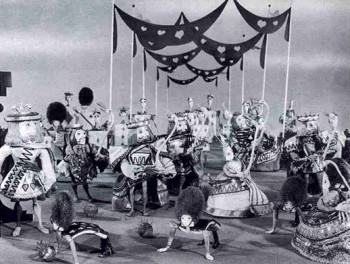 Monday night, the Museum of Modern Art had a screening of Lou Bunin‘s 1950 feature film, Alice in Wonderland. Heidi and I went to the screening that had about half of the seats filled. I’d forgotten that the film was shot in AnscoColor. This was post WWII, and England didn’t have access to the three strip Technicolor. The film was limited to red and green colors, so everything looked chartreuse or orange. In other words, ugly.
Monday night, the Museum of Modern Art had a screening of Lou Bunin‘s 1950 feature film, Alice in Wonderland. Heidi and I went to the screening that had about half of the seats filled. I’d forgotten that the film was shot in AnscoColor. This was post WWII, and England didn’t have access to the three strip Technicolor. The film was limited to red and green colors, so everything looked chartreuse or orange. In other words, ugly.
The brown mixture grew more and more annoying as the 90 minute feature progressed. The costumes were designed to exploit the two strip color hues, and this might have been a mistake. Alice was dressed in a chartreuse and orange dress, and she might have stood out more attractively had she been wearing white. In fact, the film looks much better when shown in B&W.
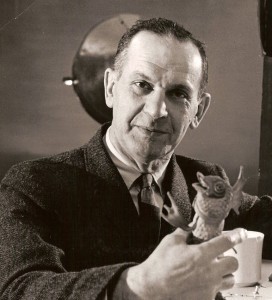 The state of puppet animation wasn’t quite so sophisticated in 1950, at least as it would seem from this feature. Many clunky character moves revealed the budget constraints of the film. The magic and grace of the George Pal shorts felt missed on Lou Bunin’s film, but there, again, the disparity of the budgets had to have been noticed.
The state of puppet animation wasn’t quite so sophisticated in 1950, at least as it would seem from this feature. Many clunky character moves revealed the budget constraints of the film. The magic and grace of the George Pal shorts felt missed on Lou Bunin’s film, but there, again, the disparity of the budgets had to have been noticed.
I briefly met and worked with Lou Bunin in the early days of my career. John Gati, a stop motion animator in New York hired me to work on a Care Free Sugarless Gum commercial. Care Free and Trident gums undressed and jumped onto a scale with Care Free weighing more for your money. It took a week to do the 20 secs. of animation in the spot. But just as we were completing animation, we learned that Trident had changed their packaging, and we had to redo the entire spot. At the end of the second week, and the second version of the spot, we learned that Care Free would update their packaging, as well, and we had to do the spot a third time. One week’s work stretched to three, but the work was getting redundant and irritating.
In the middle of that third week, Lou Bunin moved into a corner of the studio. I learned that he was doing a test spot. He was doing a version of the Lucky Charms elf as a puppet and animating it. The puppet was a beauty, and I convinced Lou to allow me to work for him (for free) to assist in the spot. I enjoyed myself for a few more days, and got to meet the man who’d made the only stop motion animated feature.
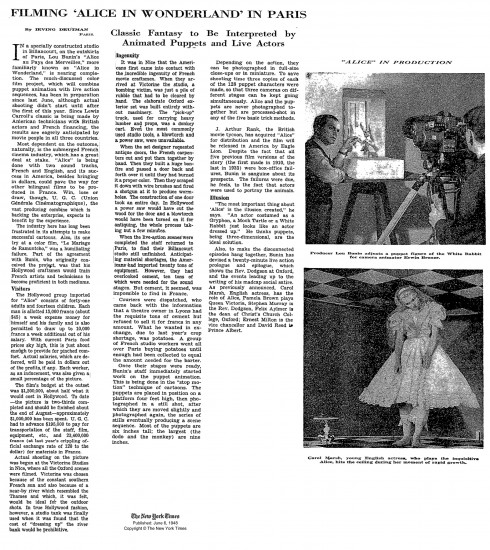
A news item during the making of Lou Bunin’s Alice.
Quay Brothers
- Just 12 hours later, at 10am on Tuesday, there was a Press showing of the Quay Brothers exhibit at MoMA. I was invited, and I took the opportunity to see the show with the fewest numbers of people who would gather around the smallish artwork. They told us where to go in the Museum (which had another hour before opening) and left us on our own. I went back in the evening to the opening party. Go here to read my review.
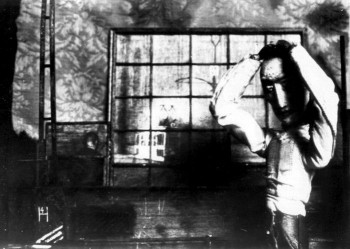 I reviewed this in detail this past Thursday. The show was exhilarating for me. Since getting the first taste of the Quay brothers back in 1980 when I saw their early film Nocturna Artificialia at the Ottawa Animation Festival. A good half of the audience didn’t know what to make of the movie and were impatient. The other half were completely taken by the film and knew it was one of the best of the films we’d seen. The jury at that festival deservedly gave top prize to Tale of Tales. That was the same year that Yurij Norshtein took the world with his masterwork of a film. Indeed, Tale of Tales was (and still is) a greater film than Nocturna Artificialia. (Interesting that Tale of Tales is a cut out animation film – essentially also stop motion.)
I reviewed this in detail this past Thursday. The show was exhilarating for me. Since getting the first taste of the Quay brothers back in 1980 when I saw their early film Nocturna Artificialia at the Ottawa Animation Festival. A good half of the audience didn’t know what to make of the movie and were impatient. The other half were completely taken by the film and knew it was one of the best of the films we’d seen. The jury at that festival deservedly gave top prize to Tale of Tales. That was the same year that Yurij Norshtein took the world with his masterwork of a film. Indeed, Tale of Tales was (and still is) a greater film than Nocturna Artificialia. (Interesting that Tale of Tales is a cut out animation film – essentially also stop motion.)
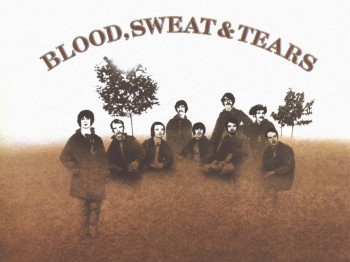 Of course, the brothers Quay are more than stop-motion filmmakers. They’ve done live action as well as documentary films; they’ve designed theater sets and books and record albums. The Blood Sweat and Tears first album cover is theirs. They were asked to design the cover without heads on the musician’s bodies. According to the brothers, the record company didn’t trust them to do the heads correctly; so the producers pasted hi-contrast images on the heads of the bodies, and they didn’t match the graphics the brothers had done. (Actually, the story isn’t properly told on the museum’s wall note; they make it sound as if the brothers had decided to leave the musicians headless, and the record company had to correct the situation. At the very least, it’s ambiguous and led to someone questioning the brothers during the museum’s Q&A.)
Of course, the brothers Quay are more than stop-motion filmmakers. They’ve done live action as well as documentary films; they’ve designed theater sets and books and record albums. The Blood Sweat and Tears first album cover is theirs. They were asked to design the cover without heads on the musician’s bodies. According to the brothers, the record company didn’t trust them to do the heads correctly; so the producers pasted hi-contrast images on the heads of the bodies, and they didn’t match the graphics the brothers had done. (Actually, the story isn’t properly told on the museum’s wall note; they make it sound as if the brothers had decided to leave the musicians headless, and the record company had to correct the situation. At the very least, it’s ambiguous and led to someone questioning the brothers during the museum’s Q&A.)
ParaNorman
- Then there’s ParaNorman. This film is scheduled to open next week. It’s a stop-motion animated feature from Laika, the company that backed Henry Selick in the making of Coraline. They got rid of Mr. Selick, and made a follow-up feature about zombies called ParaNorman. I’m scheduled to see that film tomorrow morning in an industry screening. In fact, I’ve been asked to lead the talkback, a Q&A with the directors: Chris Butler and Sam Fell. Mr. Butler had been the storyboard supervisor on Coraline, and Mr. Fell had been a director of the cgi features, Flushed Away, the first non-puppet feature from Aardman, & The Tale of Despereaux.
I’ll report on the event and review that film on Tuesday.
By the way, when I last spoke to them yesterday, I was told there’d be some extra seats. So if you’d like to see ParaNorman on Sunday at a 10am show try going to this link: ParaNorman. Note that they say that RSVPing doesn’t necessarily guarantee a seat. At the moment, I know there are seats available; hopefully everyone will be able to get in.
RSVPs.
SUNDAY, AUGUST 12TH
10:00 AM
AMC Loews Kips Bay 15
570 Second Avenue (@ East 32nd Street)
The NYTimes today has an article about ParaNorman and puppet animation.
Some After Thoughts
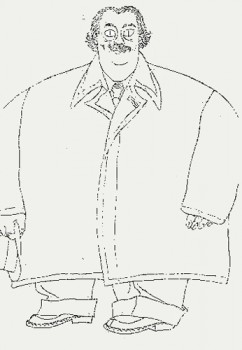 Gene Deitch‘s birthday was this week (he likes to point out that his birthday was 8/8 (August 8th when he turned 88.) He’s still keeping the blog up and he’s writing a new book. (If you haven’t read his book, How to Succeed in Animation, on AWN, go get it now – it’s free.
Gene Deitch‘s birthday was this week (he likes to point out that his birthday was 8/8 (August 8th when he turned 88.) He’s still keeping the blog up and he’s writing a new book. (If you haven’t read his book, How to Succeed in Animation, on AWN, go get it now – it’s free.
There are a couple of key things about puppet animation on his site, Roll the Credits. The information about his firendship with Jiri Trnka is worth the price of admission.It’s just great reading with lots of key photos.
Gene also has a video tour of the Kratky Puppet Studio, a walk-through with Bretislav Pojar. This is a handy llittle treasure of a video. Thanks to Gene from all of us who love puppet animation.
Commentary 14 Apr 2012 08:10 am
Some Things
- For so many years I’ve known Howard and Iris Beckerman as the couple who had their own studio, did a few commercials a year and usually had a personal film in the ASIFA East Festival each year. They always seemed to be doing what I hoped for my future, a world of animation – a world of Independence. In the recent past, Iris disappeared from the pair. She was diagnosed with Alzheimer’s Disease and needed help from a facility. Howard became more of a single at animation events, but he bore the pain of Iris’ illness well. He didn’t let on that there was any challenge in his life.
Iris died last Sunday, April 8th. She will be missed. Our thoughts are with Howard and their family, and all best wishes for them. There’s a wonderful obituary by Bill Lorenzo on the ASIFAEast site.
.
More About UPA
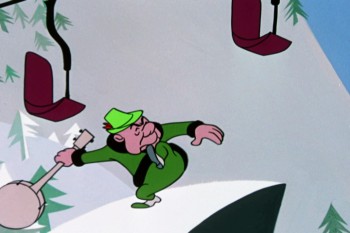 - There have been a couple of good comments on the UPA videos since last week.
- There have been a couple of good comments on the UPA videos since last week.
Mark Mayerson writes intelligently, as usual, about the bad cartoons on the 3 disc set. There’s a lot to say about them, and Mark cogently puts it all together.
Thad Komorowski also has some smart things to say on his blog. I don’t completely agree with some of his comments, but that’s irrelevant.
I just gave Tissa David a copy of the three disc set, and I’m looking to hear her comments. She probably hasn’t seen such good prints since they were originally screened in theaters. She’s also almost too candid in her thoughts about things she doesn’t like (maybe that’s where I got the bad habit of saying what I think without sparing the hurt.) When I get her comments, I’ll share them.
I hope to soon be doing some frame grab breakdowns of some of the films in the pack. I’ll enjoy studying them that way – especially the bad ones. It’ll be fun studying some of the Paul Julian backgrounds.
.
David Levy
- David Levy sent me an email packed with information. The most immediately important concerns his short film, Turning the Corner, which is playing at the Tribeca Film Festival in NY. It’s part of a program called “Shorts in Competition” and is listed as a “documentary.” The film, if you haven’t seen it is about David’s father’s difficulty and path to get into Cooper U-nion School of Art. The film has a unique style combined with the typical looseness that is part of his approach. It’s a good film.
The times for the screenings are:
_____Fri 4/20 6:00PM AMC Loews Village 7 – 1
_____Sat 4/21 11:59PM AMC Loews Village 7 – 1
_____Mon 4/23 2:30PM AMC Loews Village 7 – 3
_____Sun 4/29 7:30PM Tribeca Cinemas Theater
Naturally, the film has its own Facebook page.
David also shared some personal information. I don’t think he’d mind my sharing the good news:
- I think I’m done for blogging for the time being. I feel like I’ve said everything I wanted to and it’s not giving me pleasure to keep up with it anymore.
After five years and a good run, I closed out my home studio recently because I took an exec job at Disney. I’m the animation manager for their apps and ebooks. It’s really been a great opportunity, and forces me to stay relevant in producing animation for the newest media devices and platforms. Floyd Norman just contacted our group to rave about our Jungle Book app. That made us all really proud. I’m gonna have lots of travel to California, but my main job is based in White Plains. The long commute made me have to give up freelancing and teaching, but it feels like the right time to do so.
David, who was a smart, affable and organized President of ASIFA East for quite some time, has the good will and interest of all of us in the animation community on the East Coast. I’m sure we all wish him the best of luck in his transition to Disney and the “E” world.
.
Consuming Spirits
This also gives me an opportunity of stating, once again, the Chicago filmmaker Chris Sullivan has his Independenty produced feature Consuming Spirits premiering at the Tribeca Film Festival.
The Festival catalogue states:
- Nearly 15 years in the making, Chris Sullivan’s Consuming Spirits is a meticulously constructed tour de force of experimental animation. . . The pacing of Consuming Spirits unfolds in a slow, deliberate fashion, akin to the work of such independent filmmakers as Dennis Potter, Terence Davies, Robert Altman, and John Cassavetes. Like these live-action filmmakers, every frame of Sullivan’s animation film is crafted with attention to intricate detail. The accumulation of these images builds to a great atmospheric effect, achieved through an adroit combination of inventive set design, ever-shifting visual perspectives, fluid camera movements, a vivid color palette, and a haunting music track. Sullivan succeeds in creating, with great artistry, a hermetic, self-contained world emanating from his own unique and vivid imagination.
“Dennis Potter, Terence Davies, Robert Altman, and John Cassavetes” That’s a specific breed of filmmaker they’re comparing him to. This film should be good. I’ve seen about a half hour of it and enjoyed what I saw quite a bit.
The times for the screenings are:
_____Mon 4/23 6:00PM Clearview Cinemas Chelsea 7
_____Tue 4/24 4:00PM AMC Loews Village 7 – 2
_____Wed 4/25 7:00PM Clearview Cinemas Chelsea 5
Gene Deitch and Crockett Johnson
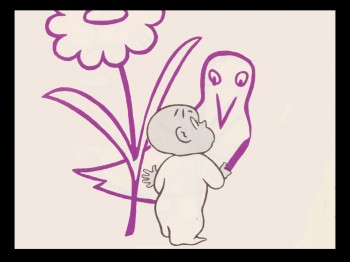 - I’ve grown to love Gene Deitch‘s weekly posts to his website. They’re all stories focussing on a particular artist or person he worked with usually reporting the making of some film or project. Many of them are my heroes like Jiri Trnka and John Hubley.
- I’ve grown to love Gene Deitch‘s weekly posts to his website. They’re all stories focussing on a particular artist or person he worked with usually reporting the making of some film or project. Many of them are my heroes like Jiri Trnka and John Hubley.
This week he talks about working with Crockett Johnson on Harold and the Purple Crayon. I’ve been a fan of Johnson’s work since I was a child. I’d already animated The Carrot Seed for HBO years ago when I’d pitched adapting Barnaby as a series. It just so happens that Sony was also pitching Harold and the Purple Crayon as a series at the same time. Guess which series they went for. However, they demanded that I represent HBO as a pair of eyes to keep abreast of what Sony was up to. So, I entered as a consultant (I can’t remember what my official title was on the films.) It meant that they sent me a lot of artwork and I say yes or no. I think my biggest contribution was in bringing Van Dyke Parks to the show as the composer of the many songs as well as the score for the series.
Needless to say, I never got to meet Crockett Johnson; he died in 1975. But it was fun to read Gene Deitch‘s report on making shorts of Harold for Weston Woods and his working with the author. As I say, these are all great stories worth reading.
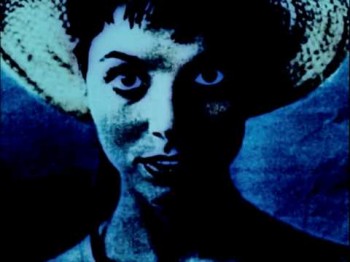 - The Polish electronic jazz group Baaba will perform live to a selection of Polish classic animated films. The program includes Academy Award-winner Zbigniew Rybczynski‘s New Book, auteur Walerian Borowczyk & Jan Lenica‘s Banner of Youth, Miroslaw Kijowicz‘s Cages (Grand Prix at Annency, 1967), as well as the visually innovative Stairs by Stanislaw Schabenbeck and Chair by Daniel Szczechura.This compilation offers a chance to see examples of “The Polish School of Animation.”
- The Polish electronic jazz group Baaba will perform live to a selection of Polish classic animated films. The program includes Academy Award-winner Zbigniew Rybczynski‘s New Book, auteur Walerian Borowczyk & Jan Lenica‘s Banner of Youth, Miroslaw Kijowicz‘s Cages (Grand Prix at Annency, 1967), as well as the visually innovative Stairs by Stanislaw Schabenbeck and Chair by Daniel Szczechura.This compilation offers a chance to see examples of “The Polish School of Animation.”
Apr 18, 7 pm
NEW YORK – Part of UNSOUND Festival
BAMcinématek
ANIMATORS
30 Lafayette Avenue, Brooklyn NY 11217
Tel 718-636-4100
Tickets: $15 general public, $10 members
Apr 27, 7 pm & 8:30 pm
DETROIT
Detroit Institute of Arts
BAABA
5200 Woodward Ave, Detroit, MI 48202
Tel 313-833-7900
Tickets: Free with museum admission.
$8 Adults, $6 Seniors, $5 Youth (6-17).
Free for children, members and Detroit residents.
Apr 29, 8 pm
LOS ANGELES – The Cinefamily
ANIMATION BREAKDOWN: Masters of Polish Animation
611 N. Fairfax Ave, Los Angeles, CA 90036
Tel 323-655-2510
Tickets: $14 / Free for members
Articles on Animation &Independent Animation &Tytla 07 Feb 2012 06:28 am
Trnka in Graphis, 1947
 - Last week I linked to a post that Gene Deitch offered covering the Centennial of Jiřà Trnka‘s birth.
- Last week I linked to a post that Gene Deitch offered covering the Centennial of Jiřà Trnka‘s birth.
That got me to look back on some of the material I have featuring this exceptional artist. One of my favorite pieces appears in Graphis Magazine published in their 1947 edition. I’d posted this article in 2008 and am offering it again. I’d cut a few pages, which I’ve restored, and have also done a better scan of the pages.
It must be remembered that this article was published before any of the great Trnka films: The Hand, Archangel Gabriel and Mother Goose, or Midsummer’s Night Dream. Much of the piece is about his illustration work.
Regardless, it’s amazing how many beautiful images appear in his earlier films featured in this article.
(Note: Graphis is printed in three languages; all of the English is included.)
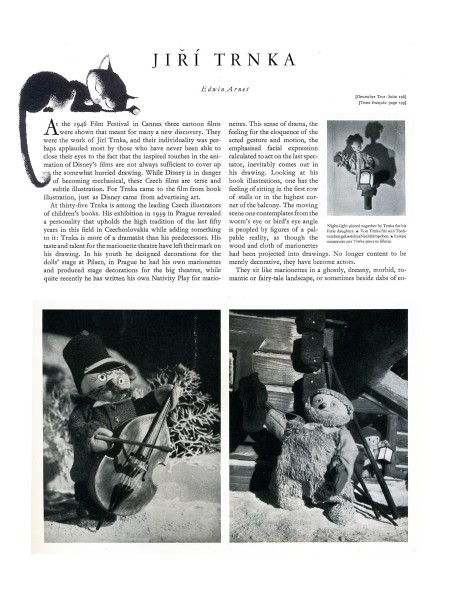 1
1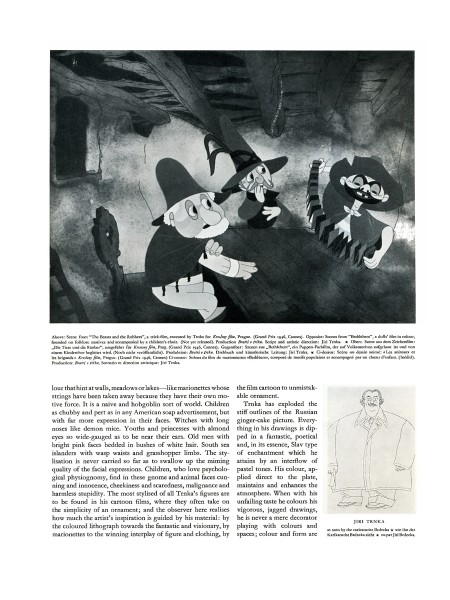 2
2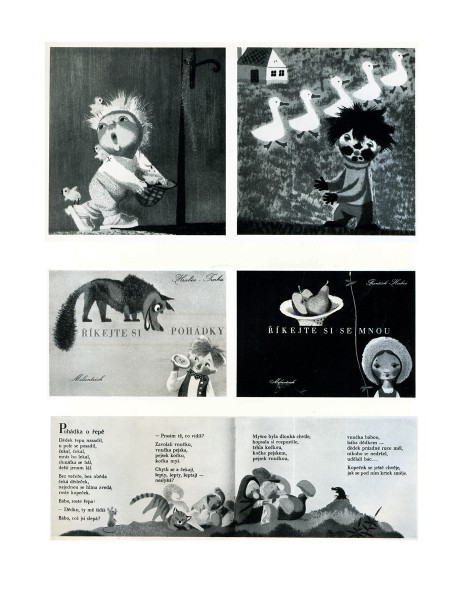 3
3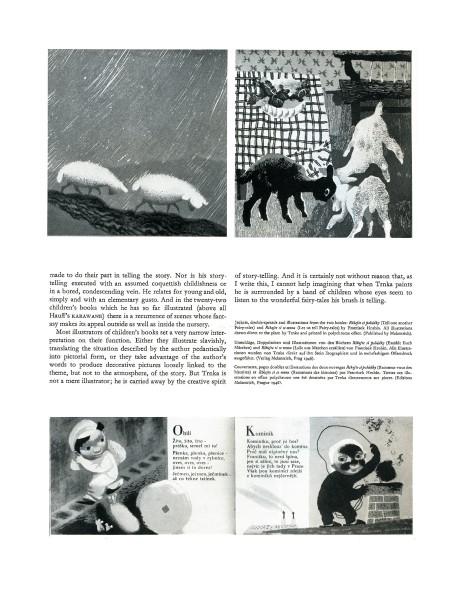 4
4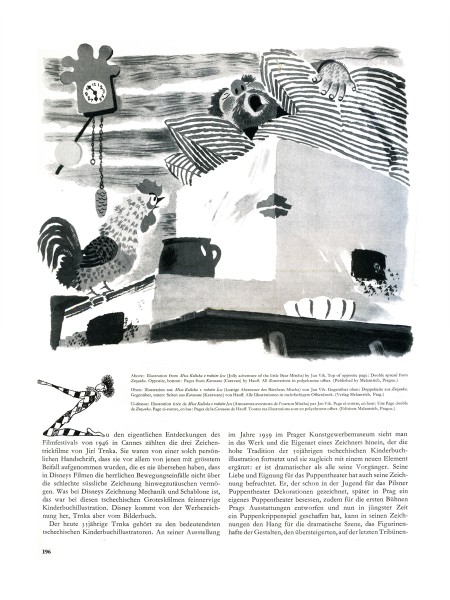 5
5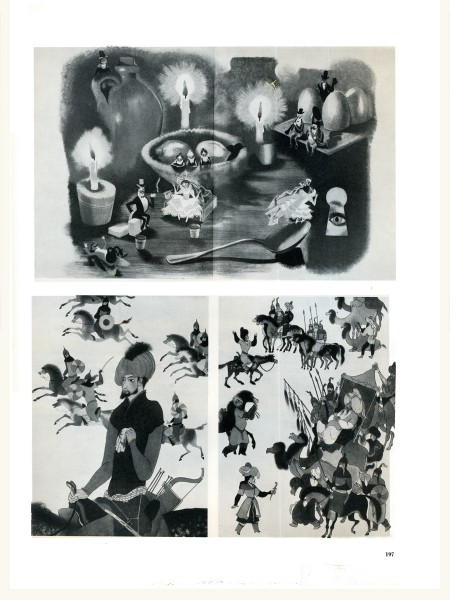 6
6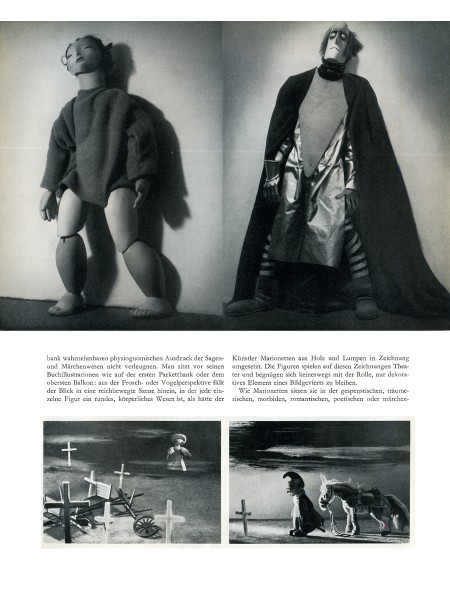 7
7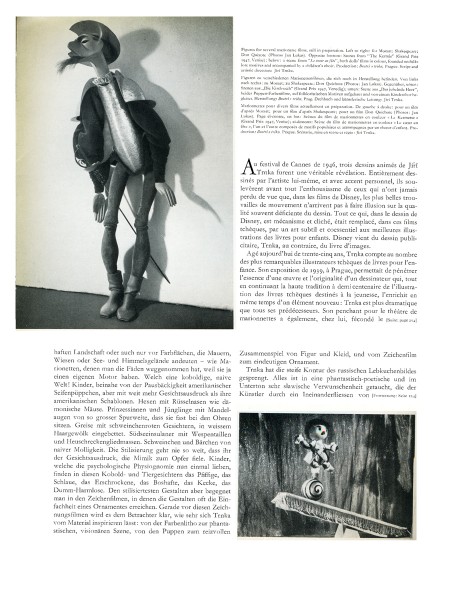 8
8
